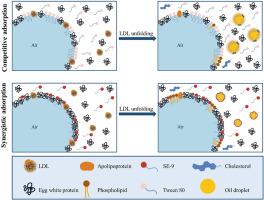Influence of synergistic/competitive interactions of nonionic emulsifiers and proteins on the foam stability of whole egg liquids: Based on air-water and oil-water dual interface perspectives
Abstract
Nonionic emulsifiers (NE) are widely used in sponge cakes because they can effectively improve the foaming properties of whole egg liquids (WEL). The WEL are rich in protein, lipids and water, forming air-water and oil-water interface during whipping and foaming. However, different NE plays different roles in the interface. No systematic study has been conducted on the stabilization mechanism of WEL by NE. This study first investigated the effect of different NE on the foaming properties of WEL. It was found that WEL with sucrose ester-9 (SE-9) had the highest foam stability (FS) (92.52%), while that with Tween 80 had the lowest (75.55%). It was found that this was related to the higher interfacial protein substitution ability of Tween 80. Next, free triglyceride content and CLSM analysis confirmed that NE promoted the formation of more oil-water interfaces in the foam. Moreover, NE could improve FS by reducing droplet size and increasing viscosity. Finally, the higher surface activity of NE than proteins was demonstrated by interfacial adsorption kinetics and dilatation rheology. SE-9 interacted with proteins at the air-water interface to enhance interfacial rigidity, whereas adsorption of Tween 80 led to a decrease in the rearrangement rate. The results also showed that the formation of oil-water interfacial films was dominated by the adsorption of NE. This study illustrated how different NE stabilized air-water and oil-water interfaces, and the effect of synergistic/competitive interactions with proteins on the stability of the interfaces. This will provide new insights into the stability regulation of WEL foam.


 求助内容:
求助内容: 应助结果提醒方式:
应助结果提醒方式:


